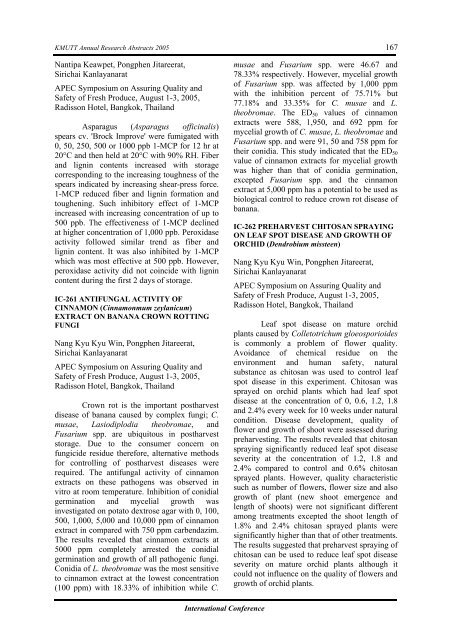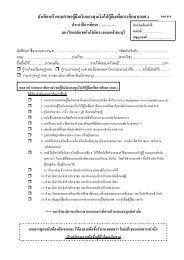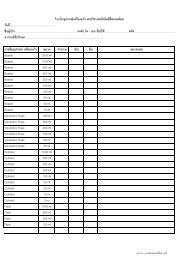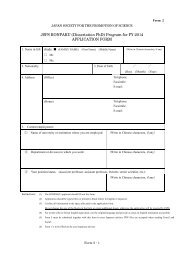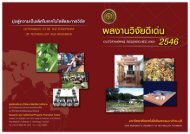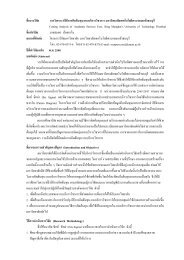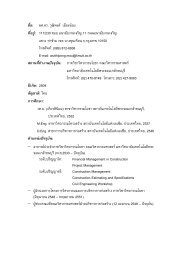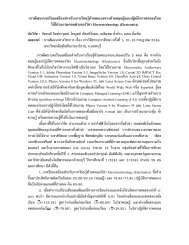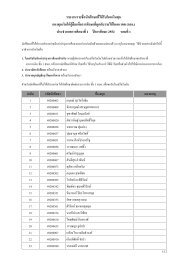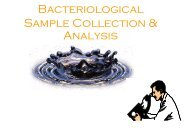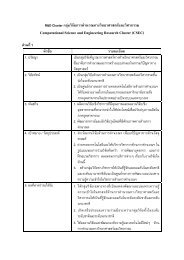You also want an ePaper? Increase the reach of your titles
YUMPU automatically turns print PDFs into web optimized ePapers that Google loves.
KMUTT Annual Research Abstracts 2005<br />
Nantipa Keawpet, Pongphen Jitareerat,<br />
Sirichai Kanlayanarat<br />
APEC Symposium on Assuring Quality and<br />
Safety of Fresh Produce, August 1-3, 2005,<br />
Radisson Hotel, Bangkok, Thailand<br />
Asparagus (Asparagus officinalis)<br />
spears cv. 'Brock Improve' were fumigated with<br />
0, 50, 250, 500 or 1000 ppb 1-MCP for 12 hr at<br />
20°C and then held at 20°C with 90% RH. Fiber<br />
and lignin contents increased with storage<br />
corresponding to the increasing toughness of the<br />
spears indicated by increasing shear-press force.<br />
1-MCP reduced fiber and lignin formation and<br />
toughening. Such inhibitory effect of 1-MCP<br />
increased with increasing concentration of up to<br />
500 ppb. The effectiveness of 1-MCP declined<br />
at higher concentration of 1,000 ppb. Peroxidase<br />
activity followed similar trend as fiber and<br />
lignin content. It was also inhibited by 1-MCP<br />
which was most effective at 500 ppb. However,<br />
peroxidase activity did not coincide with lignin<br />
content during the first 2 days of storage.<br />
IC-261 ANTIFUNGAL ACTIVITY OF<br />
CINNAMON (Cinnamonmum zeylanicum)<br />
EXTRACT ON BANANA CROWN ROTTING<br />
FUNGI<br />
Nang Kyu Kyu Win, Pongphen Jitareerat,<br />
Sirichai Kanlayanarat<br />
APEC Symposium on Assuring Quality and<br />
Safety of Fresh Produce, August 1-3, 2005,<br />
Radisson Hotel, Bangkok, Thailand<br />
Crown rot is the important postharvest<br />
disease of banana caused by complex fungi; C.<br />
musae, Lasiodiplodia theobromae, and<br />
Fusarium spp. are ubiquitous in postharvest<br />
storage. Due to the consumer concern on<br />
fungicide residue therefore, alternative methods<br />
for controlling of postharvest diseases were<br />
required. The antifungal activity of cinnamon<br />
extracts on these pathogens was observed in<br />
vitro at room temperature. Inhibition of conidial<br />
germination and mycelial growth was<br />
investigated on potato dextrose agar with 0, 100,<br />
500, 1,000, 5,000 and 10,000 ppm of cinnamon<br />
extract in compared with 750 ppm carbendazim.<br />
The results revealed that cinnamon extracts at<br />
5000 ppm completely arrested the conidial<br />
germination and growth of all pathogenic fungi.<br />
Conidia of L. theobromae was the most sensitive<br />
to cinnamon extract at the lowest concentration<br />
(100 ppm) with 18.33% of inhibition while C.<br />
167<br />
musae and Fusarium spp. were 46.67 and<br />
78.33% respectively. However, mycelial growth<br />
of Fusarium spp. was affected by 1,000 ppm<br />
with the inhibition percent of 75.71% but<br />
77.18% and 33.35% for C. musae and L.<br />
theobromae. The ED 50 values of cinnamon<br />
extracts were 588, 1,950, and 692 ppm for<br />
mycelial growth of C. musae, L. theobromae and<br />
Fusarium spp. and were 91, 50 and 758 ppm for<br />
their conidia. This study indicated that the ED 50<br />
value of cinnamon extracts for mycelial growth<br />
was higher than that of conidia germination,<br />
excepted Fusarium spp. and the cinnamon<br />
extract at 5,000 ppm has a potential to be used as<br />
biological control to reduce crown rot disease of<br />
banana.<br />
IC-262 PREHARVEST CHITOSAN SPRAYING<br />
ON LEAF SPOT DISEASE AND GROWTH OF<br />
ORCHID (Dendrobium missteen)<br />
Nang Kyu Kyu Win, Pongphen Jitareerat,<br />
Sirichai Kanlayanarat<br />
APEC Symposium on Assuring Quality and<br />
Safety of Fresh Produce, August 1-3, 2005,<br />
Radisson Hotel, Bangkok, Thailand<br />
Leaf spot disease on mature orchid<br />
plants caused by Colletotrichum gloeosporioides<br />
is commonly a problem of flower quality.<br />
Avoidance of chemical residue on the<br />
environment and human safety, natural<br />
substance as chitosan was used to control leaf<br />
spot disease in this experiment. Chitosan was<br />
sprayed on orchid plants which had leaf spot<br />
disease at the concentration of 0, 0.6, 1.2, 1.8<br />
and 2.4% every week for 10 weeks under natural<br />
condition. Disease development, quality of<br />
flower and growth of shoot were assessed during<br />
preharvesting. The results revealed that chitosan<br />
spraying significantly reduced leaf spot disease<br />
severity at the concentration of 1.2, 1.8 and<br />
2.4% compared to control and 0.6% chitosan<br />
sprayed plants. However, quality characteristic<br />
such as number of flowers, flower size and also<br />
growth of plant (new shoot emergence and<br />
length of shoots) were not significant different<br />
among treatments excepted the shoot length of<br />
1.8% and 2.4% chitosan sprayed plants were<br />
significantly higher than that of other treatments.<br />
The results suggested that preharvest spraying of<br />
chitosan can be used to reduce leaf spot disease<br />
severity on mature orchid plants although it<br />
could not influence on the quality of flowers and<br />
growth of orchid plants.<br />
International Conference


